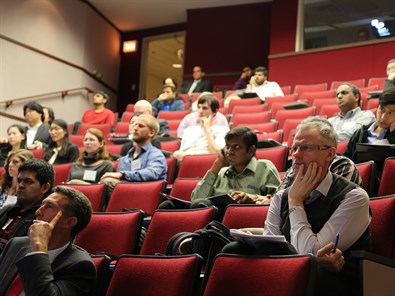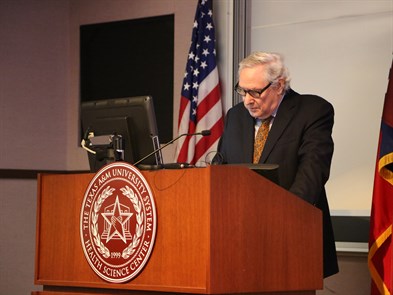
The only thing separating Texas A&M University from the largest medical facility in the world is 90 miles. A recent three-day workshop brought individuals from the Texas Medical Center and the Dwight Look College of Engineering together for a discussion about cardiovascular health and the challenges facing physicians in 2016.
The event was spearheaded by Dr. Kumbakonam Rajagopal, the J.M. Forsyth Chair, Regents Professor and Distinguished Professor in the Department of Mechanical Engineering at Texas A&M.
Some of the biggest names and brightest minds in cardiovascular medicine attended the workshop, held at the Texas A&M University Institute of Biosciences and Technology in Houston.

“The outcome we are expecting, of course, is to understand the issues and then hopefully use the skill sets we have to start writing proposals to federal agencies,” said Dr. N.K. Anand, executive associate dean of engineering and associate director of the Texas A&M Engineering Experiment Station (TEES). “We are interested in transformational research which will benefit society and humans. It could be anything from a better heart device to mitigate restriction in arteries, better sensors, better monitoring, any of these issues that will be a huge impact that we can have.”
Glen Laine, Texas A&M University vice president for research, said that as a land grant institution, Texas A&M has a responsibility to the Residents of the state of Texas.
“In this case it’s directly applicable to the health of the Residents of the state of Texas,” Laine said. “At Texas A&M, we have a long history of expertise in agriculture and engineering, and in recent years the chancellor has made it possible for our own health science center to rejoin the university.
“Having tremendous capability in the Dwight Look College of Engineering, we have looked around and found that many of the clinical assets that we need can be found within the Texas Medical Center.”
Dr. Igor Gregoric, a thoracic and cardiac surgeon, said collaborations like this are absolutely necessary.

“Without that [collaborations] it is impossible to reach the milestones and the goals for improving technology, which needs to be improved,” he said. “We still have some complications from these devices, and I think the future will be better and brighter.”
Gregoric said while physicians do the clinical portion of the equation, engineers do the technical portion.
Dr. O.H. “Bud” Frazier, a pioneer in the development of heart pumps, echoed that sentiment.
“So many of the advances in modern medicine are related to technology and the development of technology,” he said. “Pacemakers probably had a bigger influence on the health of patients than any other technology, but that of course had to do with the engineering and electronics as well.”
Frazier, who has performed more than 1,100 heart transplants in his career, said heart surgery has changed drastically over the years.
“It really depended on the technical aspect of the procedure — it depended on the doctor,” he said. “It was more art than science. One of the biggest barriers I had to overcome, was I had to work with engineers in California, or Boston, or Minneapolis. None of them were in Texas, despite the fact that we had the largest medical center in the world. I hope to see that change.”
Dr. Keshava Rajagopal, a cardiac surgeon, said what he does clinically depends on understanding cardiovascular disease, making accurate and precise diagnosis and treating diseases using state of the art technology.
“Every one of those three things is dependent on sound engineering, understanding of disease principals and as those principals are then applied and extrapolated to technology development for therapies,” he said. “We’re critically dependent upon engineers at every level for what we do, and it’s certainly my hope that workshops and symposia such as these between institutions in the Texas Medical Center and Texas A&M will foster advances in our field.”
The workshop was sponsored by the Texas A&M Engineering Experiment Station, Texas A&M Engineering and Texas A&M Mechanical Engineering.